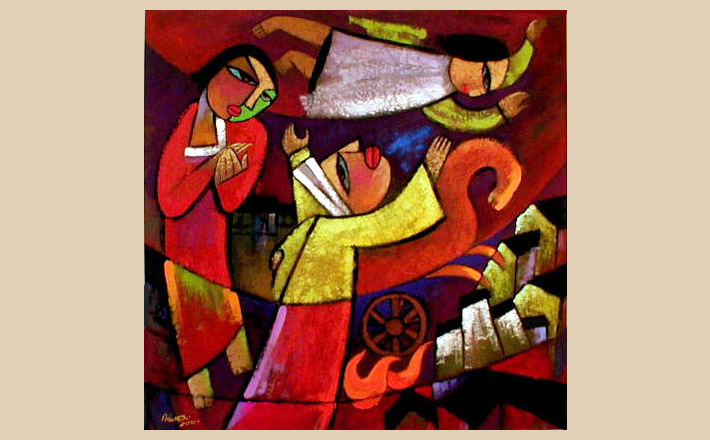Commentary on 1 Kings 19:15-16, 19-21
We find ourselves in a season of change and transition.
The theophany of 1 Kings 19 commissions the prophet to participate in the changing of the guard that included the overthrow of the House of Omri of Israel (2 Kings 9-10) and Ben Haddad of Aram (2 Kings 8:7-15) who will be replaced by Hazael. Jehu ben Nimshi will replace Ahab, the son of Omri. The political shift of personnel is paralleled on the prophetic side. There is also a transition of prophetic power.
The transition from the previous story (1 Kings 19:1-18) is short. He (Elijah) went from there. The transition to Elisha begins. Elijah “finds” Elisha which means “God is salvation.” Elijah finds Elisha plowing with a set of oxen. The twelve oxen yoke represents a sense of balance as well. The yoke of oxen probably indicates that Elisha comes from a wealthy family. The twelve yoke of oxen means there were twenty-four oxen. Elisha gives up a stable and secure life for the volatile world as a person of God.
Transition is one element in the story the use of symbol, talisman is another. The DC comics’ superheroine Wonder Woman wielded her lasso of truth. When Wonder Woman encompasses a person with the lasso of truth they cannot tell a lie. It was an instrument of power and a trademark for her character. For Elijah it was not a lasso but rather a mantel. The prophetic mantel in this story has important properties. Call narratives often turn on a speech (Exodus 3; 1 Samuel 3; Isaiah 6 etc.). But Elijah does not speak to Elisha at all. He throws his mantel over Elisha. Throwing the mantle often seems odd for several reasons. First it is not a prophetic sort of thing. While there was regalia for royalty worn by Tamar for David (2 Samuel 13:18), kings Ahab and Jehosophat (1 Kings 22:10), the priest had regalia. (See Exodus 28; Numbers 20:25-28) Later texts describe the distinctive clothing of Mordecai (Esther 6:8-9) and the priest Joshua ben Jehozadak (Zechariah 3). Nonetheless there is no evidence to support a conjectured distinctive wardrobe for prophets. The mantel functions as one of the distinguished markers of prophetic power. The Mari texts ascribes a prophet reflects the mantel alas an expression of personal commitment. The mantle reflects a distinctive artifact. It could be that the cave incident where David cut the robe of Saul while he slept amidst a war. The king’s mantel could function as a substitute for his person. The robe/mantel recurs in 2 Kings 2. However, the gesture of throwing the mantel remains uncertain.
We first see reference to the mantel of Elijah in 1 Kings 19:13 where Elijah uses the mantel to cover his face before the presence of God. The mantel separates the waters of the Jordan (2 Kings 2:8, 13-14). The reference to the parting of the waters of Jordan plays on a tradition of crossing water as a metaphor of historical transition. The first instance of crossing a body of water to mark a new social order is Exodus 14. The Exodus text uses the language “Moses stretched out his hand over the sea.” (Exodus 14:21, 26) The waters of the Jordan River separate so that the “ark of the covenant of the LORD stood on dry land in the midst of the Jordan” (Joshua 3:17b; 4:15-24) the crossing of the Sea of Reeds was the outstretched hand of Moses. The crossing of the Jordan River used Ark of the Covenant as a talisman that parted the waters. The Kings version of the crossing trope uses the mantel as the talisman. The mantel will later be a symbol of the transfer of prophetic power from Elijah to Elisha. (2 Kings 2:15)
Elisha makes an enigmatic request for a time to leave his family. Elisha says “Let me kiss my father and mother” refers to the tradition of a farewell kiss. Elijah’s grants the request. There is a conjunction ki which can function as a marker of causation or adversative particle. The causation interpretation reads the passage, “Go because what I have done to you.” If you read this as an adversative particle it would read, “Go but (remember) what I have done to you.” Either way the passage underlines the irrevocability of the call. This is an interesting text to compare with the call of the disciples of Jesus (Matthew 8:21f; Luke 9:61).
The third element in this passage is service. Elisha breaks up the wood yokes and makes a fire. He slaughters the oxen and cooks them over the fire. Well he boils the meat. But this is more than a farewell barbecue. The artifacts of his previous life now redound to the feeding of his family and friends. The symbols of the past life are consumed. Elisha serves his family and friends. This is quite different from the traditions about Saul. While both Elisha and Saul cut up oxen, they are different types of symbolic actions. Saul also cut up a team of oxen but in a quite different story. Saul cuts up a team of oxen in order to shame the other tribes into participating in the holy war. (1 Samuel 11)
The last sentence of chapter 19 sets up the narrative tension. Elisha now eats, rises, and goes after Elijah and he ministers for Elijah. Elisha may be replacing the servant Elijah left earlier (1 Kings 19:3) at Beersheba. The Hebrew verb rendered “served him” describes priestly service (e.g. Exodus 28:35; Numbers 3:6; 1 Kings 8:11), royal service (1 Chronicles 27:1; Esther 1:10; Genesis 39:4; 2 Samuel 13:7), angelic service (Psalm 103), and Joshua’s service to Moses (Exodus 24:13; 33:11; Numbers 11:28). Moses had his Joshua and Elijah has his Elisha.
The transition of prophetic power is marked by the change of the mantel of prophecy. The symbol of the mantel and crossing signals transition carry the passage. Amidst all this transition the role of service remains.


June 26, 2016